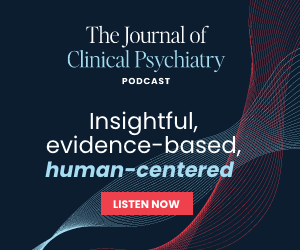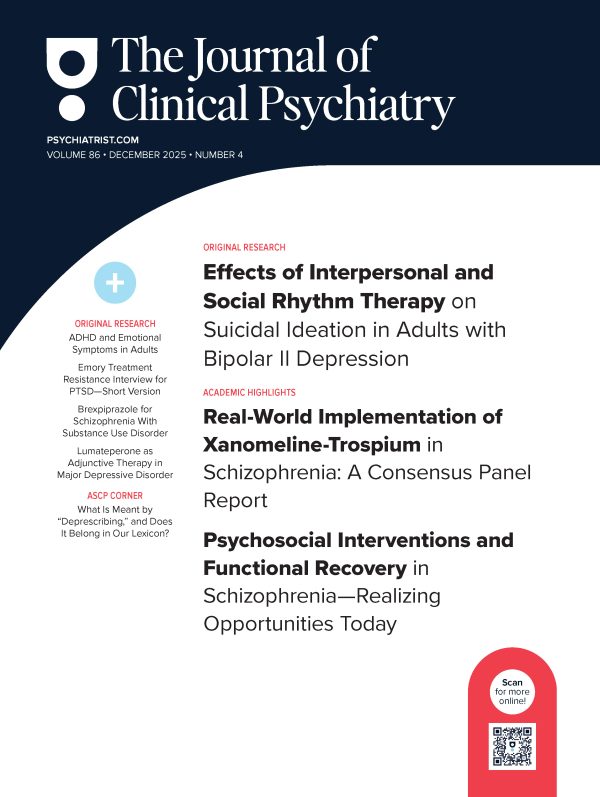
ABSTRACT
Objective: Suicidal ideation (SI) is a risk factor for completed suicide. Our previous resting state functional magnetic resonance imaging (fMRI) study found that higher amplitude of low frequency fluctuation (ALFF) in right hippocampus and thalamus was associated with SI in major depressive disorder (MDD). The present study aimed to evaluate that association in participants with bipolar disorder (BD).
Methods: Thirty depressed, adult participants with a DSM-IV diagnosis of BD had resting state fMRI scans. Region-of-interest (ROI) analyses used ALFF values within areas that were previously associated with SI in MDD. Spearman rank correlation and ordinal regression analyses were performed to assess associations between ALFF values and the SI item of the Montgomery-Asberg Depression Rating Scale. Exploratory whole-brain analyses identified regions where ALFF was associated with SI.
Results: Within the right hippocampus region, SI was positively associated with ALFF (Spearman R = 0.490, P = .0060). Ordinal regression analysis indicated that for every 0.1-unit increase in ALFF in that region, the odds of having higher SI were increased by 35% (odds ratio = 1.35; 95% confidence interval, 1.08–1.73; P = .012). Within the previously identified thalamus cluster, SI was associated with ALFF only at a trend level (Spearman R = 0.310, P = .069). Whole-brain analyses identified 3 clusters of positive association between SI and ALFF, 1 of which was located in the right hippocampus.
Conclusions: This study found that our previous finding of positive association between SI and ALFF in the right hippocampus extended to bipolar depression. Future studies should examine the clinical utility of this association, and the role of the hippocampus in SI.
Trial Registration: Data used for this secondary analysis came from studies with ClinicalTrials.gov identifiers NCT02239094 (January 2015 through September 2016) and NCT02473250 (January 2015 through December 2019).
Members Only Content
This full article is available exclusively to Professional tier members. Subscribe now to unlock the HTML version and gain unlimited access to our entire library plus all PDFs. If you’re already a subscriber, please log in below to continue reading.
References (46)

- McClay MM, O’Connor SS, Groh BN, et al. Denial of suicide attempt among hospitalized survivors of a self-inflicted gunshot wound. Psychiatr Serv. 2018;69(6):657–663. PubMed CrossRef
- Apter A, Plutchik R, Sevy S, et al. Defense mechanisms in risk of suicide and risk of violence. Am J Psychiatry. 1989;146(8):1027–1031. PubMed CrossRef
- WHO. World Heath Statistics 2021. Monitoring Health for the SDGs. WHO website. https://apps.who.int/iris/bitstream/handle/10665/342703/9789240027053-eng.pdf . 2021. Accessed March 9, 2022.
- Mann JJ, Apter A, Bertolote J, et al. Suicide prevention strategies: a systematic review. JAMA. 2005;294(16):2064–2074. PubMed CrossRef
- Mundt JC, Greist JH, Jefferson JW, et al. Prediction of suicidal behavior in clinical research by lifetime suicidal ideation and behavior ascertained by the electronic Columbia-Suicide Severity Rating Scale. J Clin Psychiatry. 2013;74(9):887–893. PubMed CrossRef
- Zou Q, Wu CW, Stein EA, et al. Static and dynamic characteristics of cerebral blood flow during the resting state. Neuroimage. 2009;48(3):515–524. PubMed CrossRef
- Li Z, Zhu Y, Childress AR, et al. Relations between BOLD fMRI-derived resting brain activity and cerebral blood flow. PLoS One. 2012;7(9):e44556. PubMed CrossRef
- Zuo XN, Di Martino A, Kelly C, et al. The oscillating brain: complex and reliable. Neuroimage. 2010;49(2):1432–1445. PubMed CrossRef
- Lan MJ, Rizk MM, Pantazatos SP, et al. Resting-state amplitude of low-frequency fluctuation is associated with suicidal ideation. Depress Anxiety. 2019;36(5):433–441. PubMed CrossRef
- Wagner G, Li M, Sacchet MD, et al. Functional network alterations differently associated with suicidal ideas and acts in depressed patients: an indirect support to the transition model. Transl Psychiatry. 2021;11(1):100. PubMed CrossRef
- Pompili M, Gonda X, Serafini G, et al. Epidemiology of suicide in bipolar disorders: a systematic review of the literature. Bipolar Disord. 2013;15(5):457–490. PubMed CrossRef
- The World Health Report 2002: Reducing Risks, Promoting Healthy Life. Geneva, Switzerland: World Health Organization; 2002.
- McIntyre RS, Berk M, Brietzke E, et al. Bipolar disorders. Lancet. 2020;396(10265):1841–1856. PubMed CrossRef
- Rush AJ, Trivedi MH, Ibrahim HM, et al. The 16-Item Quick Inventory of Depressive Symptomatology (QIDS), clinician rating (QIDS-C), and self-report (QIDS-SR): a psychometric evaluation in patients with chronic major depression. Biol Psychiatry. 2003;54(5):573–583. PubMed CrossRef
- Hamilton M. A rating scale for depression. J Neurol Neurosurg Psychiatry. 1960;23(1):56–62. PubMed CrossRef
- Lan MJ, Rubin-Falcone H, Motiwala F, et al. White matter tract integrity is associated with antidepressant response to lurasidone in bipolar depression. Bipolar Disord. 2017;19(6):444–449. PubMed CrossRef
- Montgomery SA, Asberg M. A new depression scale designed to be sensitive to change. Br J Psychiatry. 1979;134(4):382–389. PubMed CrossRef
- Lan MJ, Zanderigo F, Pantazatos SP, et al. Serotonin 1A receptor binding of [11C]CUMI-101 in bipolar depression quantified using positron emission tomography: relationship to psychopathology and antidepressant response. (online ahead of print) Int J Neuropsychopharmacol. 2022;pyac001. PubMed CrossRef
- Craddock C, Sikka S, Cheung B, et al. Towards automated analysis of connectomes: the configurable pipeline for the analysis of connectomes (c-pac). Front Neuroinform. 2013:42.
- Avants BB, Tustison NJ, Song G, et al. A reproducible evaluation of ANTs similarity metric performance in brain image registration. Neuroimage. 2011;54(3):2033–2044. PubMed CrossRef
- Friston KJ, Williams S, Howard R, et al. Movement-related effects in fMRI time-series. Magn Reson Med. 1996;35(3):346–355. PubMed CrossRef
- R Core Team. R: A language and environment for statistical computing. Vienna, Austria: R Foundation for Statistical Computing; 2021. https://www.R-project.org/.
- Winkler AM, Ridgway GR, Webster MA, et al. Permutation inference for the general linear model. Neuroimage. 2014;92:381–397. PubMed CrossRef
- Lett TA, Kennedy JL, Radhu N, et al. Prefrontal white matter structure mediates the influence of GAD1 on working memory. Neuropsychopharmacology. 2016;41(9):2224–2231. PubMed CrossRef
- Anderson MJ, Robinson J. Permutation tests for linear models. Aust N Z J Stat. 2001;43(1):75–88. CrossRef
- Smith SM, Nichols TE. Threshold-free cluster enhancement: addressing problems of smoothing, threshold dependence and localisation in cluster inference. Neuroimage. 2009;44(1):83–98. PubMed CrossRef
- Cao J, Chen X, Chen J, et al. Resting-state functional MRI of abnormal baseline brain activity in young depressed patients with and without suicidal behavior. J Affect Disord. 2016;205:252–263. PubMed CrossRef
- Tian S, Zhu R, Chattun MR, et al. Temporal dynamics alterations of spontaneous neuronal activity in anterior cingulate cortex predict suicidal risk in bipolar II patients. Brain Imaging Behav. 2021;15(5):2481–2491. PubMed CrossRef
- Gong J, Chen G, Zhou M, et al. Characteristics of temporal dynamics of intrinsic brain activity in unmedicated bipolar disorder with suicidality. Aust N Z J Psychiatry. 2020;54(11):1115–1124. PubMed CrossRef
- Fan T, Wu X, Yao L, et al. Abnormal baseline brain activity in suicidal and non-suicidal patients with major depressive disorder. Neurosci Lett. 2013;534:35–40. PubMed CrossRef
- Chase HW, Segreti AM, Keller TA, et al. Alterations of functional connectivity and intrinsic activity within the cingulate cortex of suicidal ideators. J Affect Disord. 2017;212:78–85. PubMed CrossRef
- Du L, Zeng J, Liu H, et al. Fronto-limbic disconnection in depressed patients with suicidal ideation: a resting-state functional connectivity study. J Affect Disord. 2017;215:213–217. PubMed CrossRef
- Wei S, Chang M, Zhang R, et al. Amygdala functional connectivity in female patients with major depressive disorder with and without suicidal ideation. Ann Gen Psychiatry. 2018;17(1):37. PubMed CrossRef
- Li J, Duan X, Cui Q, et al. More than just statics: temporal dynamics of intrinsic brain activity predicts the suicidal ideation in depressed patients. Psychol Med. 2019;49(5):852–860. PubMed CrossRef
- Weng JC, Chou YS, Tsai YH, et al. Connectome analysis of brain functional network alterations in depressive patients with suicidal attempt. J Clin Med. 2019;8(11):1966. PubMed CrossRef
- Chen VC, Chou YS, Tsai YH, et al. Resting-state functional connectivity and brain network abnormalities in depressive patients with suicidal ideation. Brain Topogr. 2021;34(2):234–244. PubMed CrossRef
- Ordaz SJ, Goyer MS, Ho TC, et al. Network basis of suicidal ideation in depressed adolescents. J Affect Disord. 2018;226:92–99. PubMed CrossRef
- Cao J, Ai M, Chen X, et al. Altered resting-state functional network connectivity is associated with suicide attempt in young depressed patients. Psychiatry Res. 2020;285:112713. PubMed CrossRef
- Cáceda R, Bush K, James GA, et al. Modes of Resting Functional Brain Organization Differentiate Suicidal Thoughts and Actions: A Preliminary Study. J Clin Psychiatry. 2018;79(4):17m11901. PubMed CrossRef
- Cheng X, Chen J, Zhang X, et al. Alterations in resting-state global brain connectivity in bipolar I disorder patients with prior suicide attempt. Bipolar Disord. 2021;23(5):474–486. PubMed
- Wang H, Zhu R, Dai Z, et al. Aberrant functional connectivity and graph properties in bipolar II disorder with suicide attempts. J Affect Disord. 2020;275:202–209. PubMed CrossRef
- Huang X, Rootes-Murdy K, Bastidas DM, et al. Brain Differences Associated with Self-Injurious Thoughts and Behaviors: A Meta-Analysis of Neuroimaging Studies. Sci Rep. 2020;10(1):2404. PubMed CrossRef
- Schuck A, Calati R, Barzilay S, et al. Suicide Crisis Syndrome: A review of supporting evidence for a new suicide-specific diagnosis. Behav Sci Law. 2019;37(3):223–239. PubMed CrossRef
- Fehling KB, Selby EA. Suicide in DSM-5: Current Evidence for the Proposed Suicide Behavior Disorder and Other Possible Improvements. Front Psychiatry. 2021;11:499980. PubMed CrossRef
- Huber RS, Hodgson R, Yurgelun-Todd DA. A qualitative systematic review of suicide behavior using the cognitive systems domain of the research domain criteria (RDoC) framework. Psychiatry Res. 2019;282:112589. PubMed CrossRef
- Oquendo MA, Galfalvy HC, Choo TH, et al. Highly variable suicidal ideation: a phenotypic marker for stress induced suicide risk. Mol Psychiatry. 2021;26(9):5079–5086. PubMed





